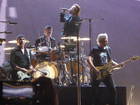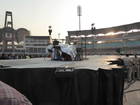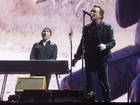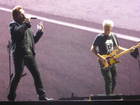Another Time, Another Place: The Boy Tour Retrospective, Part I
Oh Boy. 1980. What a monumental moment in the time of everyone’s favourite band. U2-3 was promoted at 12 shows in 18 days in southern England, a no doubt chaotic moment that featured one show being cancelled, another almost joining it, and at least two times where they were such a late addition to the bill that they weren’t even advertised at all (U2Songs has an excellent article on that hectic two-and-a-half weeks). The Come Out to Play Tour in early 1980 featured just one night outside of Ireland when they played in Newry, Northern Ireland. The second leg of the 11 O’Clock Tick Tock Tour returned to England for 20 concerts between May and July 1980.
Until the Boy Tour began, U2 had performed almost exclusively in Ireland. Their first truly international tour, which would see them cross the Atlantic between continental Europe and North America several times, lasted from 6 September 1980 to 9 June 1981. In that ten-month period they would perform a mammoth 155 times. But even though it was such an important moment in U2’s history there is a lot we don’t actually know about the Boy Tour.
We know with certainty where they played. Often we know when they played. But the most important part (for us) – WHAT they played – is poorly documented. Many of our entries for a Boy Tour setlist are blank. Where we do have a set added it is usually incomplete in some way or another. A famous saying is that we know more about the surface of the moon than about the depths of the ocean. Twisting this, it is not a joke to say that we know more about how much was charged for admittance each night – and even how many attended – than we do about what was played.
But even with all of this considered, enough information peeks through for us to make what we can consider to be reasonably accurate guesses about the content of the tour. The information presented here is all available to anyone who searches long enough. Our conclusions are speculation but we make them by building on what we know for certain, anecdotes from the band and media, and U2’s own future touring habits. Now, 42 years to the day of the Boy Tour's start, we present to you what we believe is currently the most accurate and comprehensive overview of the Boy Tour to date.
Background & Promotion
So, what do we actually know about the Boy Tour? As we’ve already said, U2 played an incredible 155 concerts in a span of 276 days. This is one night short of ZooTV for the most shows on a U2 tour. However if you include (confirmed) scheduled concerts that did not happen then the Boy Tour takes the prize as 9 planned performances were cancelled for various reasons. Somewhere in those 10 months they also found time to travel to the Bahamas to record “Fire”.
How you define a Boy Tour leg will differ based on how you look at the touring calendar. At U2Gigs we consider each time they visited a different continent to be the start of a new leg. U2Songs lists six legs, separating the five Irish shows from the rest of the European touring on leg 3 because of the month-long gap between the shows. On the other hand U2Tours lists four legs, combining the European shows at the end of the tour with the second North American leg. The band’s own official website is incomplete, listing only two legs and 69 shows with everything past 21 February in Paris not included. Finally, setlist.fm lists no legs and adds five concerts that mark the beginning of the October Tour to the end of the Boy Tour. Because... reasons, I guess.
The tour visited 12 countries including first-time trips to (in order) the Netherlands, Belgium, Scotland, France, the United States, Canada, Sweden, Germany, and Switzerland. 87 concerts took place in Europe and 69 in North America. 20 of the European events took place on the main continent, nearly half of those in the Netherlands.
Print promotion of concerts varied widely in the spelling of the group’s name. While many ads billed them correctly others called them U-2, U.2., The U2s, U●2, You Too, or V2. The V2 typo is particularly unfortunate as there was a British punk band from Manchester with that name at the time. Amusingly enough they also formed in 1976 . But my personal favourite misnaming has to be the time they were billed as VZ. Methinks whoever wrote that ad had trouble reading somebody’s handwriting...
Many concerts were promoted by local radio stations, particularly in North America during the 4th leg. We’ve recently added 8 “Interview”s from during the Boy Tour to our database that we hadn’t catalogued before; 7 of those were on radio and 1 on TV. We’ve also added 2 promotional appearances where songs were performed. This is just a drop in the ocean; there are doubtlessly some radio interviews that we are unaware of, and it doesn’t include the many, many print interviews that are hopeless to try and track.
Audience sizes varied immensely, ranging from a claimed 5 people at their concert in Berkeley to a mammoth 48,000 at the 1981 Pinkpop Festival. Audiences were typically small nearer the beginning of the tour when U2 were frequently the support act, often numbering in the 10s, but by the 4th leg most shows had figures attendance figures in the mid to high hundreds, with a few reaching several thousand.
In fact the reaction in North America to the band was so overwhelming that they even extended the tour by a month. The group’s intention was to end the tour with a 21 April 1981 concert in Pittsburgh before flying to the Bahamas to record with Steve Lillywhite, a period that saw them record “Fire”. With the reaction so impressive those plans changed and the band resumed touring with another 21 concerts added for May 1981 after that recording finished. Even some of the lower capacity crowds this late in the tour can’t be discredited; more often than not they were close to a sellout, and on a few occasions they were even over capacity; but we will get to some of those later...
Ticket prices varied widely during the tour. The information isn’t available for every show, but generally speaking tickets were cheapest at the beginning of the tour and gradually increased in price as it went on. The cost of admission was as little as £0.50 at their concerts in Wollaston and Exeter while their four shows at The Marquee – including the one eventually released by U2 as Another Time, Another Place: Live at The Marquee – each cost £1.25 for entry. Other events were held at venues that required a membership to attend; the Friars Club in Aylesbury was one such example as tickets cost £3.25 but entry would be refused without being a member. People could purchase that separately for £0.25 at the door.
Contracts
Contracts are normally fairly secretive things. They do after all include the conditions for an appearance and the fee paid to the band. But for those who are interested in such details it can be an interesting look into the background of how events are organized. Enough time has passed since the end of the Boy Tour that in a few cases the details of these contracts have been revealed. Keeping in mind that the monetary values come from 1980 and 1981, we’ll adjust the figures to their approximate value today with inflation.
On 24 September 1980 U2 were booked as a last minute support act for Rory Gallagher at the Friars Aylesbury. The initial advertisements for his performance listed Rage as the support act, but for whatever reason they were dropped from the bill and U2 were added to advertisements closer to the actual show. U2 originally had a concert in Birmingham scheduled for that night but it was cancelled, likely so they could open for Rory instead. The cost of their appearance? U2 were paid a mere £25 for this appearance, which is about £114 today according to the Bank of England’s inflation calculator. It is unknown what fee may have been offered for their Birmingham booking, but if it was cancelled in favour of supporting a major act they may well have compared that fee with the greater exposure afforded to them by opening for a star and chosen the guaranteed audience over the larger immediate payment.
There are occasional concerts where we are aware of how much U2 were paid to appeared, but in the case of their concert in Ottawa on 10 March 1981 we actually know a great deal more. As an international group the contract was only valid after “immigration and customs clearance”. Signed in February 1981, U2 were given 100% billing and the audience capacity was capped at 250 people. The band were paid $750 USD, suggesting that their other contracts for Canadian shows were also made with US currency. $750 in 1981 is just shy of $2400 today, and that fee appears to be somewhat on the lower end compared to what they received for other shows (U2Songs documents their received fees where it is known).
Their show in San Diego 4 days later is one of the strangest in U2’s history for reasons we’ve discussed before. We won’t revisit the details of that here, but we bring it up because we know the fee requested that night that the talent booker of Backdoor says he refused. In this case $1000 USD was asked for, a number that was refused under the belief that it would be too poorly attended. Today that is a bit under $3200 USD. As for Chicago... well, that is its own amusing story.
One final point of interest we will bring up is that in many cases the age of the audience was restricted, something that is clearly not a factor nowadays. Many of the venues U2 performed at were bars, night clubs, and even a casino on one night. Depending on the legal drinking age of the location and the time of the performance the audience could be all-ages or limited to those over 21 years old. In at least one case this led to rumours that the concert would be cancelled because the band members themselves were under the legal drinking age.




